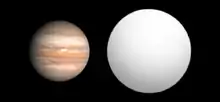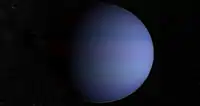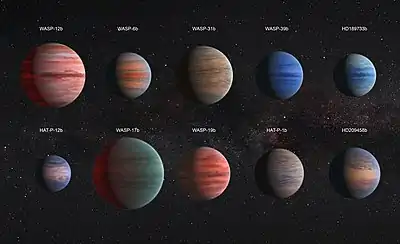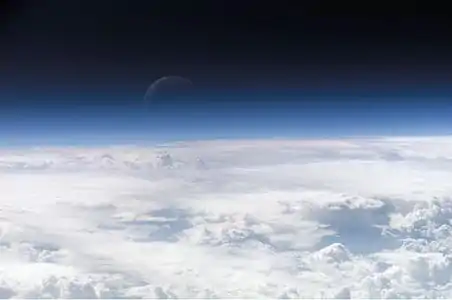HD 209458 b
HD 209458 b, also given the nickname Osiris,[2] is an exoplanet that orbits the solar analog HD 209458 in the constellation Pegasus, some 159 light-years from the Solar System. The radius of the planet's orbit is 7 million kilometres, about 0.047 astronomical units, or one eighth the radius of Mercury's orbit. This small radius results in a year that is 3.5 Earth days long and an estimated surface temperature of about 1,000 °C (about 1,800 °F). Its mass is 220 times that of Earth (0.69 Jupiter masses) and its volume is some 2.5 times greater than that of Jupiter. The high mass and volume of HD 209458 b indicate that it is a gas giant.
 Size comparison of HD 209458 b with Jupiter | |
| Discovery | |
|---|---|
| Discovered by | D. Charbonneau T. Brown David Latham M. Mayor G.W. Henry G. Marcy Kerry O'Connor R.P. Butler S.S. Vogt |
| Discovery site | High Altitude Observatory Geneva Observatory |
| Discovery date | September 9, 1999 |
| Radial velocity | |
| Orbital characteristics | |
| 0.04747 AU (7,101,000 km) | |
| Eccentricity | 0.014±0.009[1] |
| 3.52474541 ± 0.00000025 d 84.5938898 h | |
| Inclination | 86.1 ± 0.1 |
| 2,452,854.825415 ± 0.00000025 | |
| 83 | |
| Semi-amplitude | 84.26 ± 0.81 |
| Star | HD 209458 |
| Physical characteristics | |
Mean radius | 1.35 ± 0.05 RJ |
| Mass | 0.71 MJ |
Mean density | 370 kg/m3 (620 lb/cu yd) |
| 9.4 m/s2 (31 ft/s2) 0.96 g | |
| Temperature | 1,130 ± 150 |
HD 209458 b represents a number of milestones in extraplanetary research. It was the first of many categories:
- a transiting extrasolar planet
- the first planet detected through more than one method
- an extrasolar planet known to have an atmosphere
- an extrasolar planet observed to have an evaporating hydrogen atmosphere
- an extrasolar planet found to have an atmosphere containing oxygen and carbon
- one of the first two extrasolar planets to be directly observed spectroscopically
- the first extrasolar gas giant to have its superstorm measured
- the first planet to have its orbital speed measured, determining its mass directly.[3]
Based on the application of new, theoretical models, as of April 2007, it is thought to be the first extrasolar planet found to have water vapor in its atmosphere.[4][5][6][7]
In July, 2014, NASA announced finding very dry atmospheres on HD 209458 b and two other exoplanets (HD 189733 b and WASP-12b) orbiting Sun-like stars.[8]
Detection and discovery
Transits
Spectroscopic studies first revealed the presence of a planet around HD 209458 on November 5, 1999. Astronomers had made careful photometric measurements of several stars known to be orbited by planets, in the hope that they might observe a dip in brightness caused by the transit of the planet across the star's face. This would require the planet's orbit to be inclined such that it would pass between the Earth and the star, and previously no transits had been detected.
Soon after the discovery, separate teams, one led by David Charbonneau including Timothy Brown and others, and the other by Gregory W. Henry, were able to detect a transit of the planet across the surface of the star making it the first known transiting extrasolar planet. On September 9 and 16, 1999, Charbonneau's team measured a 1.7% drop in HD 209458's brightness, which was attributed to the passage of the planet across the star. On November 8, Henry's team observed a partial transit, seeing only the ingress.[9] Initially unsure of their results, the Henry group decided to rush their results to publication after overhearing rumors that Charbonneau had successfully seen an entire transit in September. Papers from both teams were published simultaneously in the same issue of the Astrophysical Journal. Each transit lasts about three hours, during which the planet covers about 1.5% of the star's face.
The star had been observed many times by the Hipparcos satellite, which allowed astronomers to calculate the orbital period of HD 209458 b very accurately at 3.524736 days.[10]
Spectroscopic
Spectroscopic analysis had shown that the planet had a mass about 0.69 times that of Jupiter.[11] The occurrence of transits allowed astronomers to calculate the planet's radius, which had not been possible for any previously known exoplanet, and it turned out to have a radius some 35% larger than Jupiter's. It had been previously hypothesized that hot Jupiters particularly close to their parent star should exhibit this kind of inflation due to intense heating of their outer atmosphere. Tidal heating due to its orbit's eccentricity, which may have been more eccentric at formation, may also have played a role over the past billion years.[12]
Direct detection
On March 22, 2005, NASA released news that infrared light from the planet had been measured by the Spitzer Space Telescope, the first ever direct detection of light from an extrasolar planet. This was done by subtracting the parent star's constant light and noting the difference as the planet transited in front of the star and was eclipsed behind it, providing a measure of the light from the planet itself. New measurements from this observation determined the planet's temperature as at least 750 °C (1300 °F). The circular orbit of HD 209458 b was also confirmed.

Spectral observation
On February 21, 2007, NASA and Nature released news that HD 209458 b was one of the first two extrasolar planets to have their spectra directly observed, the other one being HD 189733 b.[13][14] This was long seen as the first mechanism by which extrasolar but non-sentient life forms could be searched for, by way of influence on a planet's atmosphere. A group of investigators led by Jeremy Richardson of NASA's Goddard Space Flight Center spectrally measured HD 209458 b's atmosphere in the range of 7.5 to 13.2 micrometres. The results defied theoretical expectations in several ways. The spectrum had been predicted to have a peak at 10 micrometres which would have indicated water vapor in the atmosphere, but such a peak was absent, indicating no detectable water vapor. Another unpredicted peak was observed at 9.65 micrometres, which the investigators attributed to clouds of silicate dust, a phenomenon not previously observed. Another unpredicted peak occurred at 7.78 micrometres, for which the investigators did not have an explanation. A separate team led by Mark Swain of the Jet Propulsion Laboratory reanalyzed the Richardson et al. data, and had not yet published their results when the Richardson et al. article came out, but made similar findings.
On 23 June 2010, astronomers announced they have measured a superstorm (with windspeeds of up to 7000 km/h) for the first time in the atmosphere of HD 209458 b.[15] The very high-precision observations done by ESO’s Very Large Telescope and its powerful CRIRES spectrograph of carbon monoxide gas show that it is streaming at enormous speed from the extremely hot day side to the cooler night side of the planet. The observations also allow another exciting "first"—measuring the orbital speed of the exoplanet itself, providing a direct determination of its mass.[3]
Rotation
In August 2008, the measurement of HD 209458 b's Rossiter–McLaughlin effect and hence spin–orbit angle is −4.4 ± 1.4°.[16][17]
The study in 2012, updated the spin-orbit angle to -5±7°.[18]
Physical characteristics

Stratosphere and upper clouds
The atmosphere is at a pressure of one bar at an altitude of 1.29 Jupiter radii above the planet's center.[19]
Where the pressure is 33±5 millibars, the atmosphere is clear (probably hydrogen) and its Rayleigh effect is detectable. At that pressure the temperature is 2200±260 K.[19]
Observations by the orbiting Microvariability and Oscillations of STars telescope initially limited the planet's albedo (or reflectivity) below 0.3, making it a surprisingly dark object. (The geometric albedo has since been measured to be 0.038 ± 0.045.[20]) In comparison, Jupiter has a much higher albedo of 0.52. This would suggest that HD 209458 b's upper cloud deck is either made of less reflective material than is Jupiter's, or else has no clouds and Rayleigh-scatters incoming radiation like Earth's dark ocean.[21] Models since then have shown that between the top of its atmosphere and the hot, high pressure gas surrounding the mantle, there exists a stratosphere of cooler gas.[22][23] This implies an outer shell of dark, opaque, hot cloud; usually thought to consist of vanadium and titanium oxides, but other compounds like tholins cannot be ruled out yet.[22] A 2016 study indicates the high-altitude cloud cover is patchy with about 57 per cent coverage .[24] The Rayleigh-scattering heated hydrogen rests at the top of the stratosphere; the absorptive portion of the cloud deck floats above it at 25 millibars.[25]
Exosphere
Surrounding that level, on November 27, 2001, the Hubble Space Telescope detected sodium, the first planetary atmosphere outside the Solar System to be measured.[26] This detection was predicted by Sara Seager in late 2001.[27] The core of the sodium line runs from pressures of 50 millibar to a microbar.[28] This turns out to be about a third the amount of sodium at HD 189733 b.[29]
The additional data did not confirm the presence of sodium in the atmosphere of HD 209458 b[30] as in 2020.
In 2003–4, astronomers used the Hubble Space Telescope Imaging Spectrograph to discover an enormous ellipsoidal envelope of hydrogen, carbon and oxygen around the planet that reaches 10,000 K. The hydrogen exosphere extends to a distance RH=3.1 RJ, much larger than the planetary radius of 1.32 RJ.[31] At this temperature and distance, the Maxwell–Boltzmann distribution of particle velocities gives rise to a significant 'tail' of atoms moving at speeds greater than the escape velocity. The planet is estimated to be losing about 100–500 million (1–5×108) kg of hydrogen per second. Analysis of the starlight passing through the envelope shows that the heavier carbon and oxygen atoms are being blown from the planet by the extreme "hydrodynamic drag" created by its evaporating hydrogen atmosphere. The hydrogen tail streaming from the planet is approximately 200,000 kilometres long, which is roughly equivalent to its diameter.
It is thought that this type of atmosphere loss may be common to all planets orbiting Sun-like stars closer than around 0.1 AU. HD 209458 b will not evaporate entirely, although it may have lost up to about 7% of its mass over its estimated lifetime of 5 billion years.[32] It may be possible that the planet's magnetic field may prevent this loss, because the exosphere would become ionized by the star, and the magnetic field would contain the ions from loss.[33]
Presumed atmospheric water vapor
On April 10, 2007, Travis Barman of the Lowell Observatory announced evidence that the atmosphere of HD 209458 b contained water vapor. Using a combination of previously published Hubble Space Telescope measurements and new theoretical models, Barman found strong evidence for water absorption in the planet's atmosphere.[4][34][35] His method modeled light passing directly through the atmosphere from the planet's star as the planet passed in front of it. However, this hypothesis is still being investigated for confirmation.
Barman drew on data and measurements taken by Heather Knutson, a student at Harvard University, from the Hubble Space Telescope, and applied new theoretical models to demonstrate the likelihood of water absorption in the atmosphere of the planet. The planet orbits its parent star every three and a half days, and each time it passes in front of its parent star, the atmospheric contents can be analyzed by examining how the atmosphere absorbs light passing from the star directly through the atmosphere in the direction of Earth.
According to a summary of the research, atmospheric water absorption in such an exoplanet renders it larger in appearance across one part of the infrared spectrum, compared to wavelengths in the visible spectrum. Barman took Knutson's Hubble data on HD 209458 b, applied to his theoretical model, and allegedly identified water absorption in the planet's atmosphere.
On April 24, the astronomer David Charbonneau, who led the team that made the Hubble observations, cautioned that the telescope itself may have introduced variations that caused the theoretical model to suggest the presence of water. He hoped that further observations would clear the matter up in the following months.[36] As of April 2007, further investigation is being conducted.
On October 20, 2009, researchers at JPL announced the discovery of water vapor, carbon dioxide, and methane in the atmosphere.[37][38]
Magnetic field
In 2014, a magnetic field around HD 209458 b was inferred from the way hydrogen was evaporating from the planet. It is the first (indirect) detection of a magnetic field on an exoplanet. The magnetic field is estimated to be about one tenth as strong as Jupiter's.[39][40]

From top left to lower right: WASP-12b, WASP-6b, WASP-31b, WASP-39b, HD 189733b, HAT-P-12b, WASP-17b, WASP-19b, HAT-P-1b and HD 209458b.
See also
References
- Jackson, Brian; Richard Greenberg; Rory Barnes (2008). "Tidal Heating of Extra-Solar Planets". Astrophysical Journal. 681 (2): 1631–1638. arXiv:0803.0026. Bibcode:2008ApJ...681.1631J. doi:10.1086/587641.; Gregory Laughlin; Marcy; Vogt; Fischer; Butler; et al. (2005). "ON THE ECCENTRICITY OF HD 209458b". The Astrophysical Journal. 629 (2): L121–L124. Bibcode:2005ApJ...629L.121L. doi:10.1086/444558.
- "Extrasolar planet HD 209458 b (Osiris)".
- Ignas A. G. Snellen; De Kok; De Mooij; Albrecht; et al. (2010). "The orbital motion, absolute mass and high-altitude winds of exoplanet HD 209458b". Nature. 465 (7301): 1049–1051. arXiv:1006.4364. Bibcode:2010Natur.465.1049S. doi:10.1038/nature09111. PMID 20577209.
- Water Found in Extrasolar Planet's Atmosphere - Space.com
- Signs of water seen on planet outside solar system, by Will Dunham, Reuters, Tue Apr 10, 2007 8:44PM EDT
- Staff (December 3, 2013). "Hubble Traces Subtle Signals of Water on Hazy Worlds". NASA. Retrieved December 4, 2013.CS1 maint: uses authors parameter (link)
- Deming, Drake; et al. (September 10, 2013). "Infrared Transmission Spectroscopy of the Exoplanets HD 209458b and XO-1b Using the Wide Field Camera-3 on the Hubble Space Telescope". Astrophysical Journal. 774 (2): 95. arXiv:1302.1141. Bibcode:2013ApJ...774...95D. doi:10.1088/0004-637X/774/2/95.
- Harrington, J.D.; Villard, Ray (July 24, 2014). "RELEASE 14-197 - Hubble Finds Three Surprisingly Dry Exoplanets". NASA. Retrieved July 25, 2014.
- Henry et al. IAUC 7307: HD 209458; SAX J1752.3-3138 12 November 1999, reported a transit ingress on Nov. 8. David Charbonneau et al., Detection of Planetary Transits Across a Sun-like Star, November 19, reports full transit observations on September 9 and 16.
- Castellano; Jenkins, J.; Trilling, D. E.; Doyle, L.; Koch, D. (March 2000). "Detection of Planetary Transits of the Star HD 209458 in the Hipparcos Data Set". The Astrophysical Journal Letters. University of Chicago Press. 532 (1): L51–L53. Bibcode:2000ApJ...532L..51C. doi:10.1086/312565. PMID 10702130.
- Notes for star HD 209458
- Jackson, Brian; Richard Greenberg; Rory Barnes (2008). "Tidal Heating of Extra-Solar Planets". Astrophysical Journal. 681 (2): 1631–1638. arXiv:0803.0026. Bibcode:2008ApJ...681.1631J. doi:10.1086/587641.
- NASA's Spitzer First To Crack Open Light of Faraway Worlds Archived 2007-07-15 at the Wayback Machine
- Richardson, L. Jeremy; Deming, D; Horning, K; Seager, S; Harrington, J; et al. (2007). "A spectrum of an extrasolar planet". Nature. 445 (7130): 892–895. arXiv:astro-ph/0702507. Bibcode:2007Natur.445..892R. doi:10.1038/nature05636. PMID 17314975.
- Rincon, Paul (23 June 2010). "'Superstorm' rages on exoplanet". BBC News London. Retrieved 2010-06-24.
- Winn, Joshua N. (2009). "Measuring accurate transit parameters". Proceedings of the International Astronomical Union. 4: 99–109. arXiv:0807.4929. Bibcode:2009IAUS..253...99W. doi:10.1017/S174392130802629X.
- Winn, Joshua N.; et al. (2005). "Measurement of Spin-Orbit Alignment in an Extrasolar Planetary System". The Astrophysical Journal. 631 (2): 1215–1226. arXiv:astro-ph/0504555. Bibcode:2005ApJ...631.1215W. doi:10.1086/432571.
- Obliquities of Hot Jupiter host stars: Evidence for tidal interactions and primordial misalignments, 2012, arXiv:1206.6105
- A. Lecavelier des Etangs; A. Vidal-Madjar; J.-M. Désert; D. Sing (2008). "Rayleigh scattering by H in the extrasolar planet HD 209458b". Astronomy & Astrophysics. 485 (3): 865–869. arXiv:0805.0595. Bibcode:2008A&A...485..865L. doi:10.1051/0004-6361:200809704.
- Rowe, Jason F.; Matthews, Jaymie M.; Seager, Sara; Sasselov, Dimitar; Kuschnig, Rainer; Guenther, David B.; Moffat, Anthony F. J.; Rucinski, Slavek M.; Walker, Gordon A. H.; Weiss, Werner W. (2009). "Towards the Albedo of an Exoplanet: MOST Satellite Observations of Bright Transiting Exoplanetary Systems". Proceedings of the International Astronomical Union. 4: 121–127. arXiv:0807.1928. Bibcode:2009IAUS..253..121R. doi:10.1017/S1743921308026318.
- Matthews J., (2005), MOST SPACE TELESCOPE PLAYS `HIDE & SEEK' WITH AN EXOPLANET; LEARNS ABOUT ATMOSPHERE AND WEATHER OF A DISTANT WORLD
- Hubeny, Ivan; Burrows, Adam (2009). "Spectrum and atmosphere models of irradiated transiting giant planets". Proceedings of the International Astronomical Union. 4: 239–245. arXiv:0807.3588. Bibcode:2009IAUS..253..239H. doi:10.1017/S1743921308026458.
- Dobbs-Dixon, Ian (2009). "Radiative Hydrodynamical Studies of Irradiated Atmospheres". Proceedings of the International Astronomical Union. 4: 273–279. arXiv:0807.4541. Bibcode:2009IAUS..253..273D. doi:10.1017/S1743921308026495.
- MacDonald (November 2018). "And now for the exoweather". New Scientist: 40.
- Sing, David K.; Vidal‐Madjar, A.; Lecavelier Des Etangs, A.; Désert, J.‐M.; Ballester, G.; Ehrenreich, D. (2008). "Determining Atmospheric Conditions at the Terminator of the Hot Jupiter HD 209458b". The Astrophysical Journal. 686 (1): 667–673. arXiv:0803.1054. Bibcode:2008ApJ...686..667S. doi:10.1086/590076.
- I. A. G. Snellen, S. Albrecht, E. J. W. de Mooij, and R. S. Le Poole (2008). "Ground-based detection of sodium in the transmission spectrum of exoplanet HD 209458b". Astronomy & Astrophysics. 487 (1): 357–362. arXiv:0805.0789. Bibcode:2008A&A...487..357S. doi:10.1051/0004-6361:200809762.CS1 maint: multiple names: authors list (link)
- Seager; Whitney, B. A.; Sasselov, D. D. (2000). "Photometric Light Curves and Polarization of Close‐in Extrasolar Giant Planets". The Astrophysical Journal. 540 (1): 504–520. arXiv:astro-ph/0004001. Bibcode:2000ApJ...540..504S. doi:10.1086/309292.
- Sing, David K.; Vidal‐Madjar, A.; Lecavelier Des Etangs, A.; Désert, J.‐M.; Ballester, G.; Ehrenreich, D. (2008). "Determining Atmospheric Conditions at the Terminator of the Hot Jupiter HD 209458b". The Astrophysical Journal. 686: 667–673. arXiv:0803.1054. Bibcode:2008ApJ...686..667S. doi:10.1086/590076.
- Seth Redfield; Michael Endl; William D. Cochran; Lars Koesterke (20 January 2008). "Sodium Absorption from the Exoplanetary Atmosphere of HD 189733b Detected in the Optical Transmission Spectrum". The Astrophysical Journal Letters. 673 (673): L87–L90. arXiv:0712.0761. Bibcode:2008ApJ...673L..87R. doi:10.1086/527475.
- Casasayas-Barris, N.; Palle, E.; Yan, F.; Chen, G.; Luque, R.; Stangret, M.; Nagel, E.; Zechmeister, M.; Oshagh, M.; Sanz-Forcada, J.; Nortmann, L.; Alonso-Floriano, F. J.; Amado, P. J.; Caballero, J. A.; Czesla, S.; Khalafinejad, S.; Lopez-Puertas, M.; Lopez-Santiago, J.; Molaverdikhani, K.; Montes, D.; Quirrenbach, A.; Reiners, A.; Ribas, I.; Sanchez-Lopez, A.; Zapatero Osorio, M. R. (2020). "Is there NaI in the atmosphere of HD 209458b? Effect of the centre-to-limb variation and Rossiter-McLaughlin effect in transmission spectroscopy studies". arXiv:2002.10595 [astro-ph.EP].
- Ehrenreich, D.; Lecavelier Des Etangs, A.; Hébrard, G.; Désert, J.-M.; Vidal-Madjar, A.; McConnell, J. C.; Parkinson, C. D.; Ballester, G. E.; Ferlet, R. (2008). "New observations of the extended hydrogen exosphere of the extrasolar planet HD 209458b". Astronomy and Astrophysics. 483 (3): 933–937. arXiv:0803.1831. Bibcode:2008A&A...483..933E. doi:10.1051/0004-6361:200809460.
- Hébrard, G.; Lecavelier des Étangs, A.; Vidal-Madjar, A.; Désert, J. -M.; Ferlet, R. (2003). Jean-Philippe Beaulieu; Alain Lecavelier des Étangs; Caroline Terquem (eds.). "Evaporation rate of hot Jupiters and formation of Chthonian planets". Extrasolar Planets: Today and Tomorrow. ASP Conference Proceedings. 321: 203–204. arXiv:astro-ph/0312384. Bibcode:2004ASPC..321..203H. ISBN 978-1-58381-183-2. 30 June - 4 July 2003, Institut d'astrophysique de Paris, France.
- Semeniuk, Ivan (September 1, 2009). "Can Magnetism Save a Vaporizing Planet?". Retrieved Oct 30, 2014.
- Barman (2007). "Identification of Absorption Features in an Extrasolar Planet Atmosphere". The Astrophysical Journal Letters. 661 (2): L191–L194. arXiv:0704.1114. Bibcode:2007ApJ...661L.191B. doi:10.1086/518736.
- First sign of water found on an alien world - space - 10 April 2007 - New Scientist Space
- J.R. Minkle (April 24, 2007). "All Wet? Astronomers Claim Discovery of Earth-like Planet". Scientific American.
- "Astronomers do it Again: Find Organic Molecules Around Gas Planet". October 20, 2009.
- "Organic Molecules Detected in Exoplanet Atmosphere". October 20, 2009.
- Unlocking the Secrets of an Alien World's Magnetic Field, Space.com, by Charles Q. Choi, November 20, 2014
- Kislyakova, K. G.; Holmstrom, M.; Lammer, H.; Odert, P.; Khodachenko, M. L. (2014). "Magnetic moment and plasma environment of HD 209458b as determined from Ly observations". Science. 346 (6212): 981–4. arXiv:1411.6875. Bibcode:2014Sci...346..981K. doi:10.1126/science.1257829. PMID 25414310.
Further reading
- Charbonneau, D. (2003). "HD 209458 and the Power of the Dark Side". In Deming, Drake; Seager, Sara (eds.). Scientific Frontiers in Research on Extrasolar Planets. ASP Conference Series. 294. San Francisco: ASP. pp. 449–456. ISBN 978-1-58381-141-2..
- Deming, Drake; Seager, Sara; Richardson, L. Jeremy & Harrington, Joseph (2005). "Infrared radiation from an extrasolar planet". Nature. 434 (7034): 740–743. arXiv:astro-ph/0503554. Bibcode:2005Natur.434..740D. doi:10.1038/nature03507. PMID 15785769..
- Fortney, J. J.; Sudarsky, D.; Hubeny, I.; Cooper, C. S.; Hubbard, W. B.; Burrows, A.; Lunine, J. I. (2003). "On the Indirect Detection of Sodium in the Atmosphere of the Planetary Companion to HD 209458". Astrophysical Journal. 589 (1): 615–622. arXiv:astro-ph/0208263. Bibcode:2003ApJ...589..615F. doi:10.1086/374387..
- Holmström, M.; Ekenbäck, A.; Selsis, F.; Penz, T.; Lammer, H. & Wurz, P. (2008). "Energetic neutral atoms as the explanation for the high-velocity hydrogen around HD 209458b". Nature. 451 (7181): 970–972. arXiv:0802.2764. Bibcode:2008Natur.451..970H. doi:10.1038/nature06600. PMID 18288189..
External links
| Wikimedia Commons has media related to HD 209458 b. |
- "European astronomers observe first evaporating planet". Hubble Space Telescope. ESA/NASA. 2003-03-12. Retrieved 2008-06-28.
- Hubble Finds Three Surprisingly Dry Exoplanets
- Hogan, Jenny (2005-03-22). "Glow of alien planets glimpsed at last". NewScientist. Retrieved 2008-06-28.
- "Hubble Makes First Direct Measurements of Atmosphere on World Around another Star". Hubble Space Telescope. NASA. 2001-11-27. Retrieved 2008-06-28.
- McKee, Maggie (2004-02-03). "Oxygen seen streaming off exoplanet". NewScientist. Retrieved 2008-06-28.
- "NASA's Spitzer Marks Beginning of New Age of Planetary Science". Jet Propulsion Laboratory. NASA. 2005-03-22. Retrieved 2008-06-28.
- "Oxygen and carbon discovered in exoplanet atmosphere 'blow-off'". Hubble Space Telescope. ESA/NASA. 2004-02-02. Retrieved 2008-06-28.
- Peplow, Mark (2005-03-23). "Light from alien planets confirmed". Nature. doi:10.1038/news050321-9. Retrieved 2008-06-28.
- AAVSO Variable Star Of The Season. Fall 2004: The Transiting Exoplanets HD 209458 and TrES-1

